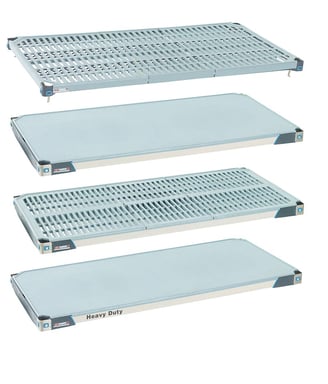You know what they say: It’s better to build up than out.
Storage space is a major plus in any New York City restaurant. From cooking essentials to table wares and kitchen supplies, it’s crucial for chefs, restaurant managers, and staff to have room for all the ingredients necessary for a successful venture in the restaurant industry.
Metro has been elevating storage for generations, paying special attention to foodservice storage and productivity solutions for restaurants in New York and beyond. But when outfitting your kitchen, walk-ins, and other back-of-house spaces with Metro shelving, is it better to choose chrome wire or high-quality polymer units?
Once again, Sam Tell turns to PBAC & Associates sales rep Joshua Erdheim to help organize some answers.
Sam Tell: What are the pros and cons of Metro wire shelving units?
Joshua Erdheim: The pros of wire shelving include versatility, as well as the variety of options in terms of sizing and length, and the capability of creating your own shelving systems. There’s also the affordability and the economics of it. It's not that it's more cost effective than some of the other alternatives out there—instead, it's rugged, it's durable, and it lasts forever, as long as you maintain it.
As for cons, there aren’t many, but it could potentially chip or rust over time. And there is some difficulty in cleaning it, particularly in moist environments that tend to leave some residue on the shelving. But it’s tried and true. It works and it’s what has worked for 75 years. And it's locally manufactured and sourced in Wilkes Barre, Pennsylvania. So you know, it's made in America.
ST: What are the pros and cons of MetroMax polymer shelving units?
JE: Polymer shelving is made of high-resin polymers. So they are constructed to be extremely heavy duty. They are also robust, but being that they are a polymer, they are anti-corrosion, anti-rust, anti-chip or break. And with the polymer, they have removable mats on the shelves, and with that, that makes it easy to clean. You can easily remove parts, wash down all the components until they are fresh and new. There is a bit of a higher cost factor, so that could be a slight drawback for some of the smaller establishments.
ST: Which has a stronger weight capacity, wire or polymer shelving? And what is the weight capacity for each variety?
JE: They both have the same weight capacity. Each is rated for about 2,000 pounds per unit maximum and 800 pounds per shelf.
ST: When it comes to wet storage vs. dry storage, when would wire be better and when would polymer be better?
JE: For wet environments, I think polymer is a better solution. When you're in a walk-in, the natural properties of metal make it more likely for corrosion or rust to build. With polymer, there’s a built-in resistance to moisture. So I definitely recommend polymer for walk-ins, considering the temperature changes. For dry ingredients, things like flour or other ingredients in bags, or even sheets or linens, I’m a big fan of wire. It’s very practical. These are soft materials, so there’s nothing that will dent or crack or chip the shelf. But for items that are heavier or in cans or some type of metal, I think polymer is the answer.
ST: How is the MetroMax polymer shelving the more customizable option? 
JE: Polymer and wire both have very similar features in terms of being able to connect shelves together and angle them at a right angle or in a certain way with S hooks and intermediate hooks—they both have generally the same capabilities of configuration.
ST: What is post-sharing and which variety is capable of it?
JE: Both systems have the ability to share posts. When you want to connect two units together to maximize a space, instead of having two individual units you can have two units connect to one another with S hooks or clips and they would share a common post. It’s a great way to maximize space and increase efficiency.
ST: How does different ceiling heights factor into the decision-making process of wire vs. polymer?
JE: Metro has a standard post height. They would most commonly be 74 and 86 inches high. That is our two most popular heights. But if there's a walk-in room that's 70 inches high, we have 63 inch posts, if there's a room that’s 61 inches high, we have 54 inch posts. And sometimes customers are looking for something much, much lower to make a customer work table or something along those lines. But both wire and polymer are available in various heights.
ST: What if you need the ability to move shelving? Which is the better option?
JE: Within the polymer or wire, it doesn't make a difference. When I’m working with a customer, one of my first questions is “are you looking for a stationary or mobile unit?” Within all shelving systems, whether it’s chrome wire or polymer, we offer both stationary and mobile. And really the main difference is the mobile units have casters attached to them and this aids in mobility. There are different kinds of casters—some are polymer, some are rubber and the type of caster you need would depend on the flooring. And the casters have brakes, as well.
ST: Which option is easier to assemble, wire or polymer shelving?
JE: They're both simple. Whether it's wire or polymer, either way it’s shipped as a shelf. There’s no shelf assembly required. The unit must be assembled, but it’s as simple as four posts being clipped together. Sometimes, if you’re dealing with an exceedingly high post, you might have to lay the unit on its side, but in general both polymer and wire are quite easy to assemble.
ST: Which option is better for tight spaces?
JE: Technically, you can go a little more narrow with the wire shelving, as it has a minimum depth of 14 inches. This is as opposed to the polymer shelving, which has a minimum depth of 18 inches deep. So if you’ve got a really tight space, you might want to go with wire.
ST: Can Metro customize either of these options with different colors or finishes to make them more front-of-house friendly? 
JE: Metro does offer designer colors for some of the shelving. In fact, they just came out with a gray epoxy finish that’s definitely more appealing for the front of the house. They also offer stainless steel, which is another great look for front-of-house spaces. There’s a variety of different finishes, which could fit aesthetically into various spots in certain establishments.
ST: What are the warranties for each unit?
JE: There’s a general one year warranty on the wire shelving. Then you have a 15-year warranty on the MetroMax Q. And a lifetime warranty on the MetroMax.
ST: Which is the better option for restaurants on a budget?
JE: A mom-and-pop spot or any restaurant that’s smaller and using the shelving for linens or flour—and budget is a question—I would go with the chrome wire shelving.
ST: Why might it be more worthwhile to spend money on polymer?
JE: There’s just a better level of longevity and durability with the polymer. It’s also much easier to clean. And if you’re a restaurant that’s storing lots of heavy items with a hard exterior, polymer is not going to chip or corrode and it will absolutely hold the weight.








